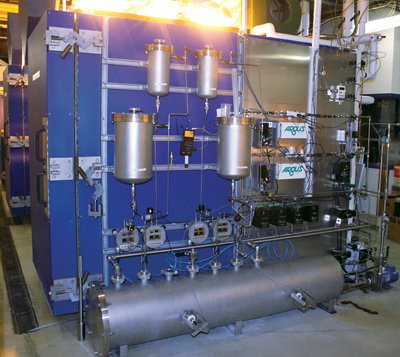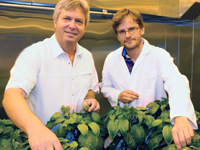
Concerns over nutrient solutions leaching into local water sources could cost greenhouse producers dearly.
Concerns over nutrient solutions leaching into local water sources could cost greenhouse producers dearly. They now face new environmental legislation that could make it increasingly difficult for new greenhouses to be built or expanded.
 |
|
|
|
A large part of this environmental problem, says University of Guelph researcher Prof. Mike Dixon, stems from ineffective and outdated nutrient sensor technologies in greenhouses. These don’t allow producers to keep accurate tabs on the exact measurements and concentrations of individual nutrient ingredients – such as nitrate and phosphorus – within the nutrient solutions being fed to their plants.
Dixon, a plant scientist and director of the Controlled Environment Systems Research Facility at the University of Guelph, is collaborating with the Canadian Space Agency, INO (an optics company from Quebec), as well as COMDEV Canada Ltd, an aerospace technology company, to develop and build an improved nutrient sensor system.
PINPOINTING EXACT CONCENTRATIONS OF INDIVIDUAL IONS IN NUTRIENT SOLUTION
After more than a decade of research, Dixon says that now he and his researchers are closer than ever before to creating an advanced nutrient sensor that is able to pinpoint the exact concentrations of individual ions in a nutrient solution and give producers immediate, on-the-fly feedback.
Dixon says that these improved nutrient sensors will play a major role in helping greenhouse producers mitigate environmental concerns, such as nutrient solutions leaching into groundwater, and provide them with a more effective, economical way to manage and recycle nutrient solutions.
“You need to be able to detect these ingredients independently and modify the nutrient solution recipe on the basis of real-time management and measurement solutions that are reliable and economical,” says Dixon. “And until we perfect better sensor technology and economical technical approaches to solve these management problems, it will remain a serious problem – one the whole greenhouse industry needs to get behind.”
 |
|
| Prof. Mike Dixon (left) checks plant material with research assistant Cody Thompson; (top) The U of G barometric chambers. PHOTOS BY BRUCE SARGENT/SPARK |
DEVELOPING A NEW CLASS OF SENSOR TECHNOLOGY
Indentifying each individual nutrient ingredient, or ion, is accomplished by using a new class of sensor technology – called optrodes – that Dixon and his colleagues have been developing with the Canadian Space Agency.
The optrodes are basically an array of tiny sensors that work by detecting variations in each ion’s properties after they make contact with a specific chemical on an optic fibre, or translucent plate. Each of these sensors responds differently to whichever ions make contact with them. Each ion – whether it is nitrate, calcium or potassium – produces a unique reaction to the various sensors by changing colour. From this, producers are then able to get an exact readout of each individual ingredient present in their nutrient solutions.
Dixon says that the nutrient sensor system itself would look like a small, shoebox-sized black box containing an array of sensors, along with a thin tube feeding small solution samples through the box and past the sensors as they detect and react to each ion.
In getting their improved nutrient sensor into the greenhouse, Dixon says that he and his team have made major headway integrating the sensor system with conventional greenhouse plumbing setups. They are also developing operational software so that the sensor will work smoothly alongside conventional greenhouse nutrient management and delivery systems.
THE SENSORS COULD BE READY FOR COMMERCIAL WITHIN TWO YEARS
The new ion sensor is still undergoing further design and testing to ensure the sensor will withstand day-to-day use in a commercial greenhouse environment. Next, Dixon and his team plan to trial the sensor in controlled environment chambers and small-scale greenhouses. After this final testing phase, the researchers hope to have the sensor system ready for use in commercial-scale greenhouse systems within the next 24 months.
But aside from its eventual use in Canadian greenhouses, Dixon sees this new ion sensor technology and work into nutrient recycling and management as something that provides a key link to his other longtime research into finding sustainable ways of growing and producing food in space.
The same technological innovations and solutions needed to produce food in space have direct connections to the terrestrial greenhouse industry. Dixon says that the goal of sending manned missions to Mars, the moon and beyond should be used as the driving force for advancements in greenhouse technologies, such as the nutrient sensor.
NASA WORK IS ALL RELEVANT TO CHALLENGES FACED BY GROWERS
“That’s the technical pull, the driver is clearly the desire to spin off as much useful technology to the terrestrial agri-food sector – especially the greenhouse sector – as we can,” says Dixon. “Everything we’re doing is directly relevant to the problems and solutions required in the greenhouse industry today.”
Also involved in this study is doctoral student Matt Bamsey, who is working with Dr. Alain Berinstain, Director of Space Astronomy and Planetary Exploration with the Canadian Space Agency.
Dixon’s work receives support from the Ontario Ministry of Agriculture, Food and Rural Affairs, the Ontario Centres of Excellence, Flowers Canada through the Cecil Delworth Foundation, as well as the Natural Sciences and Engineering Research Council of Canada.
Joey Sabljic is a student writer with SPARK (Students Promoting Awareness of Research Knowledge) at the University of Guelph.
Print this page